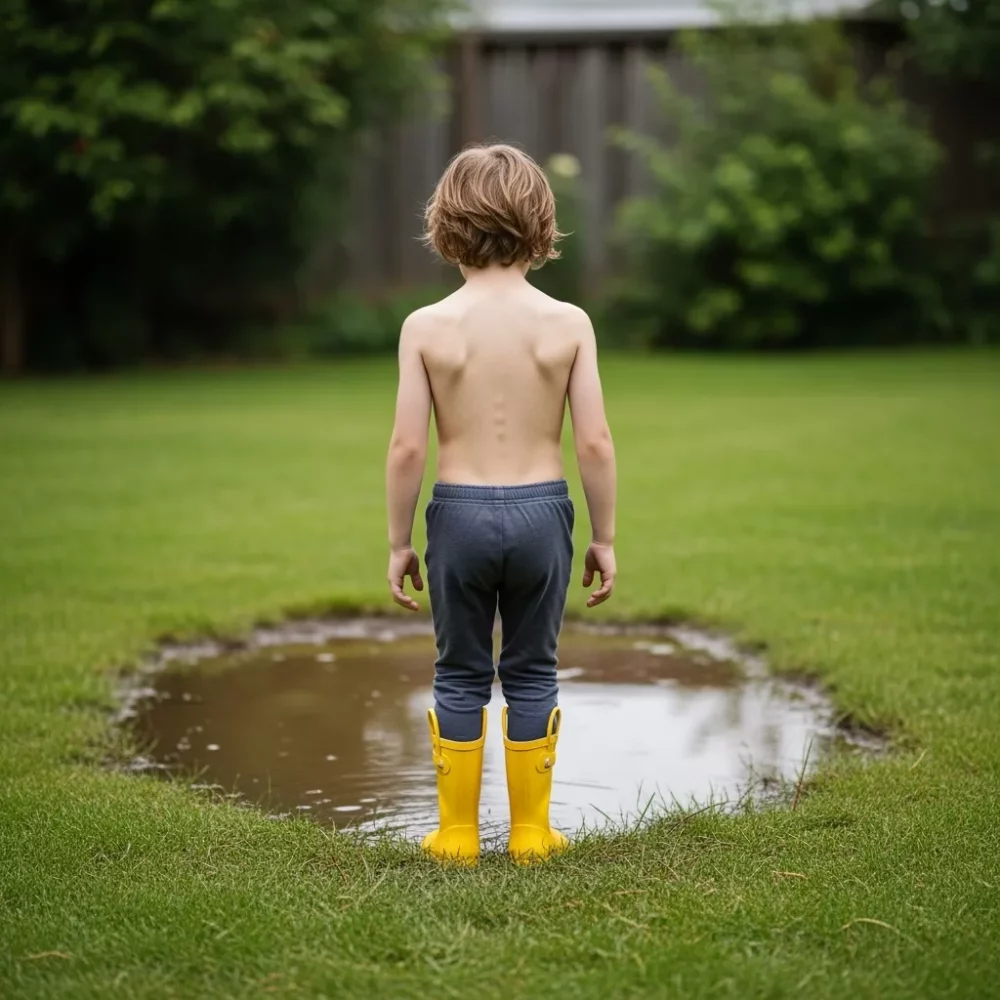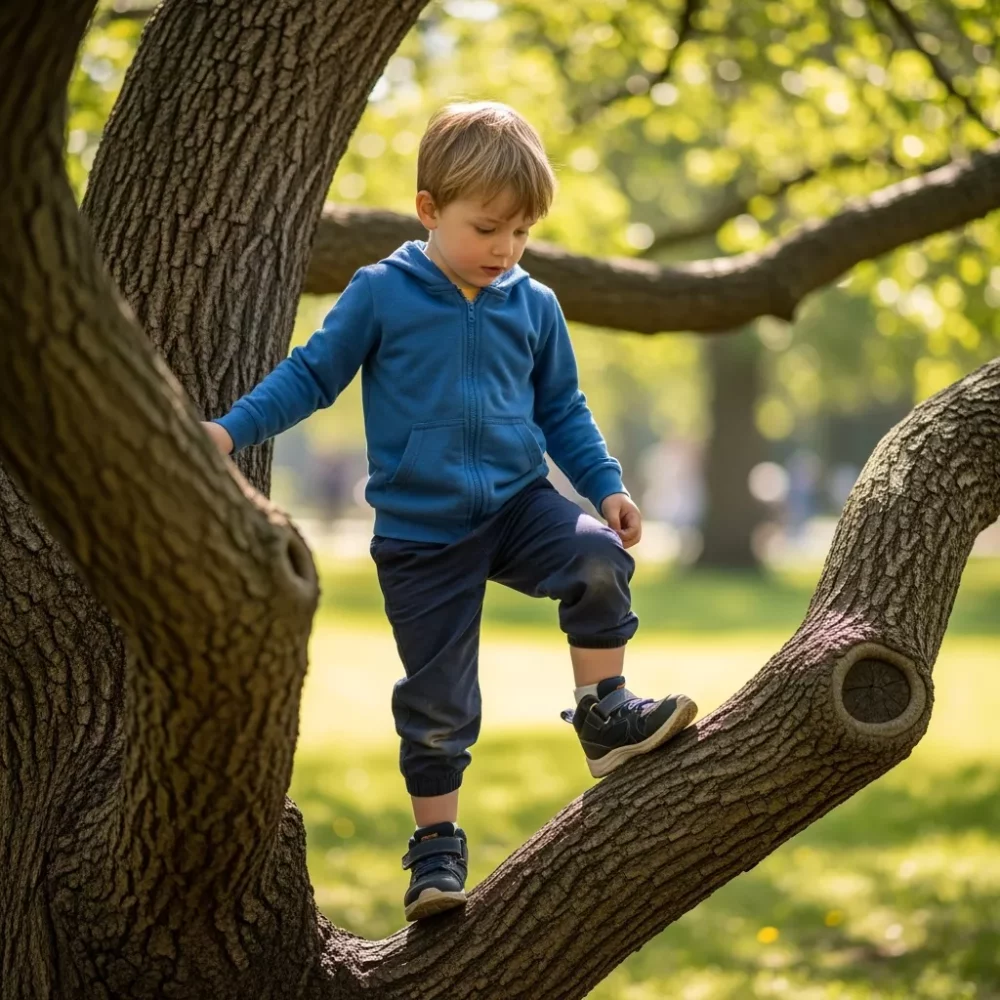As a parent or a teacher, your first instinct is to keep children safe. You see a child climbing a little too high or running a little too fast, and your heart skips a beat. We wrap our kids in a protective bubble because we want to shield them from every possible bump, scrape, and fall.
But what if some of those risks were actually good for them? What if letting them climb that tree or balance on that log was teaching them something important? It feels like a contradiction. You want to protect them, but you also want them to grow into capable, confident people. This is the big question many of us face when we think about how kids play.
This constant worry can make playtime stressful for adults. It’s a tough spot to be in, wanting to encourage freedom while also feeling responsible for their safety.
Why We Worry So Much
That feeling of worry is completely normal. A recent study showed that over half of parents (56.6%) are mainly concerned about their kids getting physically hurt during play. We picture broken bones, scraped knees, or worse. It’s natural to want to prevent any harm from coming to them.
This fear isn’t just a general feeling. It’s tied to specific activities that make our palms sweat.
The Scariest Types of Play
When parents were asked what types of play worried them the most, two things stood out. Water-related activities were the biggest concern for almost everyone (90.9%). Sliding activities, like on a playground slide, also made many parents nervous (88.4%).
These fears make sense. Water can be dangerous, and a fall from a high slide can be serious. Knowing exactly what worries us is the first step to figuring out how to handle it.
But it seems not everyone is even talking about this in the same way.
Are We All on the Same Page?
Interestingly, while most parents have heard of “risky play” (about 77%), nearly a third have not. This means some of us are encouraging kids to test their limits, while others might see the same actions as just being reckless. This difference in understanding can cause confusion and disagreement between parents and teachers.
To get on the same page, we first need to agree on what risky play actually is.
What “Risky Play” Really Means
When you hear the term “risky play,” you might picture kids doing truly dangerous things with no supervision. But that’s not what it is. Risky play is not about ignoring safety. It is about letting children explore and challenge themselves in a thrilling way, where they feel like they are in control.
It’s the excitement a child feels when they climb one branch higher than before or swing just a little faster. They are learning to recognize and manage their own limits.
These activities are more than just fun. They are powerful learning experiences.

Different Kinds of Risky Fun
Risky play comes in many forms. Each type helps children develop different skills. Here is a simple table that breaks down some common types of risky play and the amazing benefits they offer.
| Type of Risky Play | What It Looks Like | What Kids Learn |
|---|---|---|
| Play with Heights | Climbing trees, jungle gyms, or small walls. | Builds confidence, improves balance, and helps them judge space. |
| Play with Speed | Running fast, riding bikes, swinging high. | Develops coordination, helps them understand their body’s limits. |
| Play with Tools | Using real tools like a small hammer or screwdriver with supervision. | Teaches responsibility, improves fine motor skills, and shows cause and effect. |
| Play Near Elements | Playing near water, a small fire, or on slippery surfaces. | Teaches respect for nature, helps them learn about safety rules. |
| Rough-and-Tumble Play | Play fighting, wrestling, and chasing. | Helps them read social cues, learn self-control, and build friendships. |
| Play Where You Can “Disappear” | Building forts, hiding in bushes, or exploring alone in a safe area. | Fosters independence, sparks creativity, and builds problem-solving skills. |
As you can see, these activities are not about being careless. They are about learning and growing in a hands-on way.
“Play is the highest form of research.” – Albert Einstein
This idea reminds us that when children are playing, they are actively learning about the world around them.
This type of research builds more than just physical strength. It builds a stronger mind.
The Amazing Things Kids Learn from Taking Chances
When a child takes a small, manageable risk, their brain gets a workout. They have to think, plan, and solve problems on the spot. For example, a child figuring out the best way to get down from a play structure is learning to assess a situation and make a decision.
This kind of thinking is a skill they will use for the rest of their lives, from solving a math problem to navigating a tricky social situation.
These experiences also do wonders for their self-esteem.
Building Confidence, One Step at a Time
Think about the look on a child’s face when they finally make it across the monkey bars or balance on a narrow beam. That look is pure pride and accomplishment. Each time they overcome a small challenge, they build a little more belief in themselves.
They learn the powerful lesson that they are capable and strong. This confidence doesn’t just stay on the playground. It follows them into the classroom and beyond, encouraging them to try new things without being afraid to fail.
This process also teaches them how to handle some very strong emotions.
Learning to Manage Fear
Risky play is thrilling because it mixes fear with excitement. When children engage in these activities, they learn to listen to their bodies. They learn to tell the difference between “this is scary but I can do it” and “this is truly unsafe.”
This is an important life skill. It helps them develop good judgment and emotional control. They learn how to feel scared, take a deep breath, and decide what to do next, which is something many adults still struggle with.
So, how can we give kids these benefits while still keeping them safe?

How to Keep Kids Safe Without Stopping the Fun
The goal is not to get rid of all risks. That would be impossible and would rob kids of important learning opportunities. The real goal is to manage the environment so that children can take good risks, not bad ones.
This means we need to get rid of serious dangers, or hazards, while leaving the challenges, or risks. For example, a broken piece of glass on the playground is a hazard and should be removed. A tall slide is a risk that a child can choose to take on.
You can do this by taking a few practical steps.
Simple Steps for Safer Risky Play
Parents and teachers have an important role as safety managers, not as guards who stop all action. Here are a few things you can do:
- Scan the Area First: Before playtime, do a quick check for real dangers like sharp objects, unstable equipment, or anything that could cause an unexpected injury.
- Supervise from a Distance: Be present and attentive, but try not to jump in too quickly. Give children the space to solve their own problems. If you see them struggling, ask questions instead of giving answers.
- Talk About It: Use words to help them think about risk. You can ask, “What’s your plan for getting down?” or “Do you feel steady on that log?” This teaches them to think before they act.
- Start Small: Encourage them to build their skills slowly. A child who learns to balance on a low beam will eventually be ready for a higher one. Let them decide when they are ready for the next step.
Knowing how to do this is what gives adults the confidence to allow risky play.
The Power of Knowing What to Do
The study found that parents and teachers are eager to learn more about how to manage risk. They want information and programs that teach them how to create a safe space for these important activities. This shows that the problem isn’t that adults are against risky play. The problem is they don’t always feel equipped to handle it.
When you have the right knowledge, you can feel confident letting your kids explore. You can stop worrying so much and start enjoying watching them grow.
This shift in thinking can change everything.
Moving Forward with Confidence
Childhood is meant to be a time of adventure and discovery. While the instinct to protect our children is strong, we must remember that they also need challenges to thrive. Risky play is not about being careless. It is a vital part of development that teaches kids confidence, problem-solving, and resilience.
The fear of injury is real, but it can be managed. By learning to tell the difference between a real hazard and a healthy risk, we can create environments where kids are safe but not stifled.
By supervising thoughtfully and talking openly about safety, you empower children to understand their own limits. You give them the tools to navigate their world with courage and good judgment. So take a deep breath, and let them play. You might be surprised at what they can do.